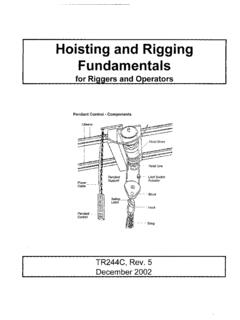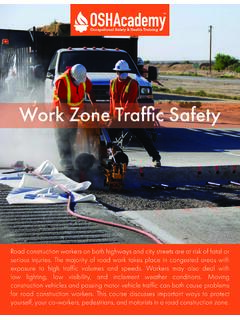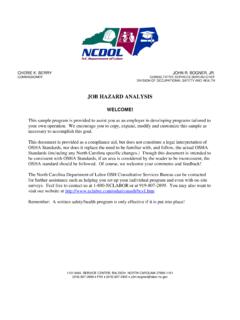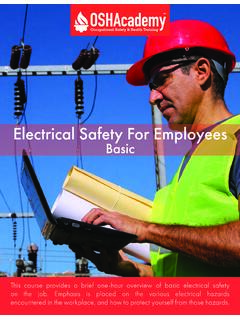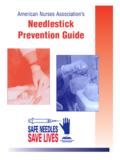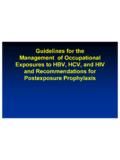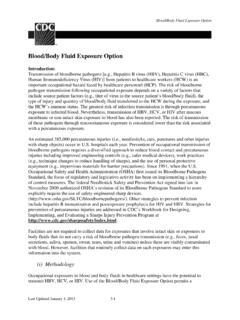Transcription of Tattoo and Body Art Safety - OSHAcademy
1 Creating living art is a unique talent, but it puts tattooists at risk of coming in contact with their client's blood. This means artists may also be exposed to bloodborne pathogens, such as hepatitis B virus, hepatitis C virus, or human immunodeficiency virus (HIV). This course will discuss ways to prevent cross-contamination and how to properly clean and sanitize tools and and body Art Safety This page intentionally blank OSHA cademy Course 607 Study Guide Tattoo and body Art Safety Copyright 2017 Geigle Safety Group, Inc. No portion of this text may be reprinted for other than personal use.
2 Any commercial use of this document is strictly forbidden. Contact OSHA cademy to arrange for use as a training document. This study guide is designed to be reviewed off-line as a tool for preparation to successfully complete OSHA cademy Course 607. Read each module, answer the quiz questions, and submit the quiz questions online through the course webpage. You can print the post-quiz response screen which will contain the correct answers to the questions. The final exam will consist of questions developed from the course content and module quizzes. We hope you enjoy the course and if you have any questions, feel free to email or call: OSHA cademy 15220 NW Greenbrier Parkway, Suite 230 Beaverton, Oregon 97006 +1 (888) 668-9079 Disclaimer This document does not constitute legal advice.
3 Consult with your own company counsel for advice on compliance with all applicable state and federal regulations. Neither Geigle Safety Group, Inc., nor any of its employees, subcontractors, consultants, committees, or other assignees make any warranty or representation, either express or implied, with respect to the accuracy, completeness, or usefulness of the information contained herein, or assume any liability or responsibility for any use, or the results of such use, of any information or process disclosed in this publication. GEIGLE Safety GROUP, INC., DISCLAIMS ALL OTHER WARRANTIES EXPRESS OR IMPLIED INCLUDING, WITHOUT LIMITATION, ANY WARRANTIES OF MERCHANTABILITY OR FITNESS FOR A PARTICULAR PURPOSE.
4 Taking actions suggested in this document does not guarantee that an employer, employee, operator or contractor will be in compliance with applicable regulations. Ultimately every company is responsible for determining the applicability of the information in this document to its own operations. Each employer s Safety management system will be different. Mapping Safety and environmental management policies, procedures, or operations using this document does not guarantee compliance regulatory requirements. This page intentionally blank Course 607 Contents Course Introduction .. 1 Course Objectives .. 1 Module 1: Safety Considerations.
5 2 Introduction .. 2 Universal Precautions and Regulations .. 2 Prevent needlestick injuries .. 2 Sharps Disposal Container .. 3 exposure Control Plan .. 4 OSHA Interpretation .. 4 Module 1 Quiz .. 6 Module 2: Reducing exposure .. 7 Risks Associated with Tattooing .. 7 Reducing Cross-Contamination .. 8 Gloves .. 8 Hand Washing .. 8 Disposable Supplies .. 9 Skin Infections Among Tattoo Recipients .. 9 Disinfecting Surfaces .. 10 Cleaning Tools and Equipment .. 10 Sterilization Machines .. 11 Module 2 Quiz .. 12 This page intentionally blank Course 607 Copyright 2017 Geigle Safety Group, Inc. Page 1 of 12 Course Introduction Creating living art is a unique talent, but it puts tattooists and piercers at risk of coming in contact with their client's blood.
6 This means artists may also be exposed to bloodborne pathogens, such as hepatitis B virus, hepatitis C virus, or human immunodeficiency virus (HIV). From wearing gloves to sanitizing tools and machines, there are ways to prevent these serious and often deadly diseases. This course will discuss the things you, as an employee, can do to lessen the risks associated with tattooing and body piercing. It will also discuss ways to prevent cross-contamination and how to properly clean and sanitize tools and machines. Course Objectives This course will focus on each of these topics from the employee's perspective. The course will also explain the employer's responsibilities.
7 By the end of this course you should be able to: Explain the risks of tattooing Explain your rights as an employee under the universal precautions Describe what a sharps disposal container is used for Describe ways to prevent needlestick injuries Explain ways to prevent cross-contamination Explain the use of gloves and other protective equipment Describe skin infections among Tattoo recipients Describe how to disinfect surfaces Describe how to clean tools and equipment Course 607 Copyright 2017 Geigle Safety Group, Inc. Page 2 of 12 Module 1: Safety Considerations Introduction Artists can be exposed to bloodborne pathogens, such as viruses and bacteria, during the set-up, procedure, break down, and clean-up stages.
8 These exposures can occur through needlesticks, contact with dried blood on equipment or surfaces, or blood splashes in the eyes, nose, or mouth. Keeping a clean shop and using safe work practices, ensures a safe and professional atmosphere for artists and clients. Universal Precautions and Regulations Universal Precautions which some Tattoo artists refer to as a sterile chain of events is a set of precautionary steps defined by the Center for Disease Control (CDC) to prevent the spread of disease. Tattoo artists are required by law to follow Universal Precautions for the Safety of themselves and their clients. Any artist found not following this sterile chain of events can have their licensing and/or certification revoked.
9 Any studio found not following the guidelines can be shut down. The basics include things like using gloves and other barriers on anything the artist comes in contact with, disinfecting all surfaces and general cross-contamination prevention. When these things are followed, the chances of being exposed to staph infection of any kind are very minimal. Tattooing and piercing regulations and recommended practices vary from state to state in the United States. To learn more about your state s regulations associated with tattooing and bloodborne pathogens, click here: ( ) Prevent needlestick injuries Exposures to bloodborne pathogens can happen by getting stuck with a used needle or getting cut by a sharp instrument that has blood on it.
10 Certain practices can reduce needlesticks and other sharps injuries . Here is some additional information for preventing exposures to blood in the body art industry. Course 607 Copyright 2017 Geigle Safety Group, Inc. Page 3 of 12 Sharps Disposal Container Disposable piercing needles, Tattoo needles, and razors must be discarded into a sharps disposal container. body artists must throw away used or contaminated sharps into a sharps disposal container. It is safer to put disposable razors into a sharps disposal container rather than the trash. This will protect the person changing or handling the trash bag from getting cut with a used razor.
